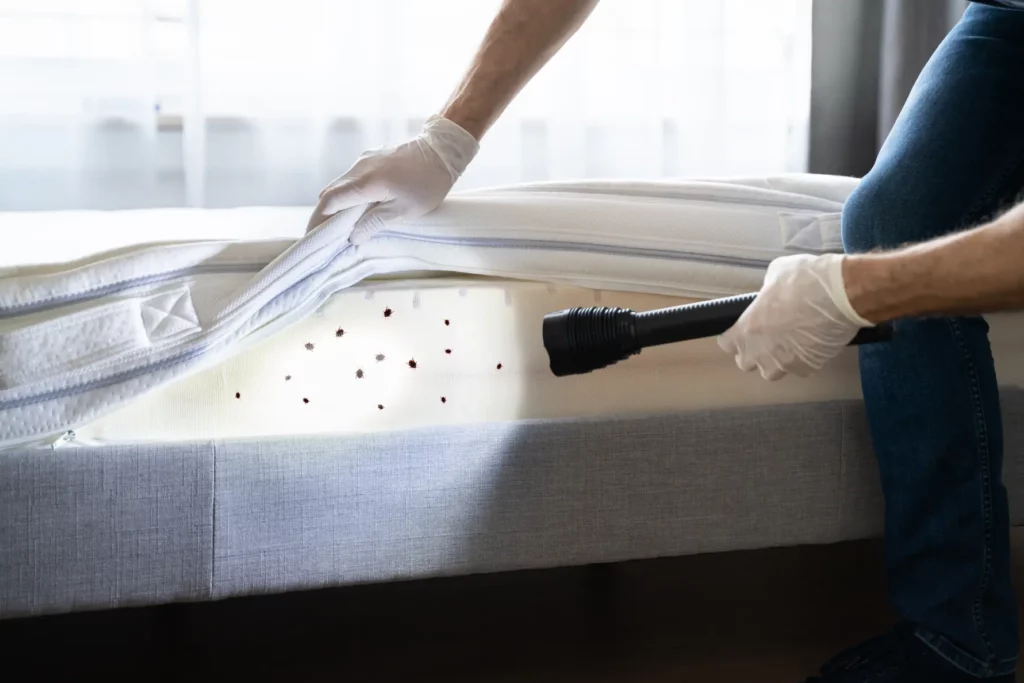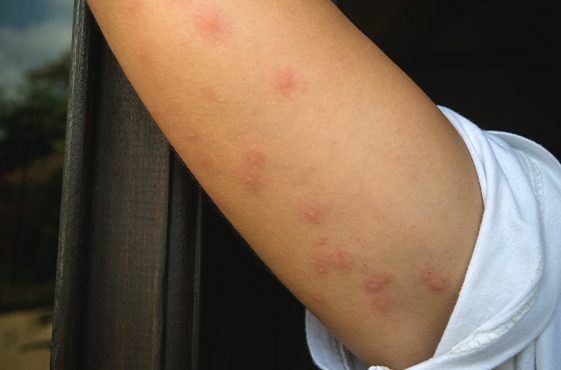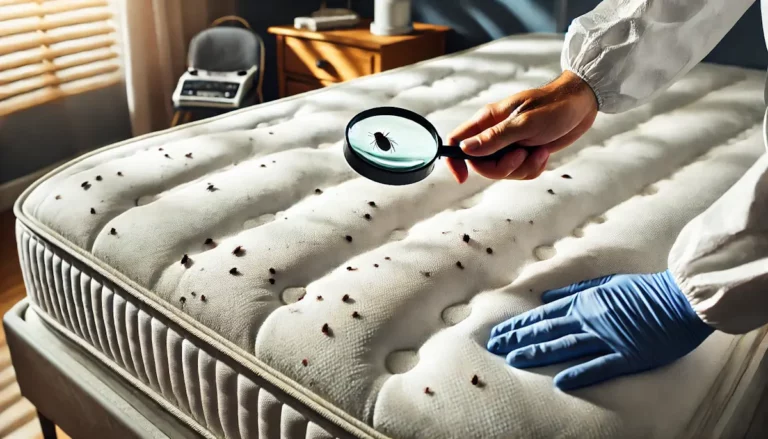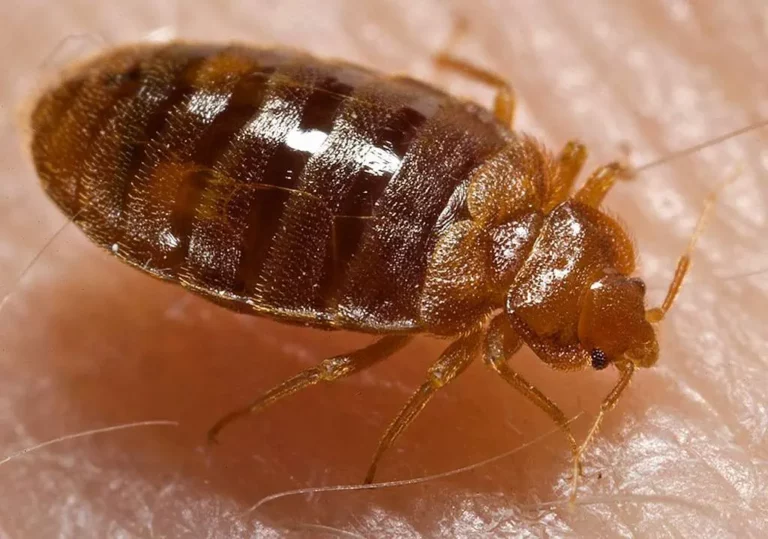Table of Contents
ToggleIdentifying Bed Bug Infestation

Bed bugs can be a common issue in homes, rentals, and during travel. These tiny pests are nocturnal and feed on human blood, often leaving behind itchy bites. Recognizing the signs of bed bug infestation is crucial for early detection and effective treatment.
A clear indication of a bed bug problem is discovering bites on your body that you cannot explain, typically after waking up. These bites often appear as tiny, red, and cause itching. Also, there might be blood marks on your bed linens or pillowcases, which could result from inadvertently crushing a bed bug during your sleep.
Additionally, the presence of bed bugs can be inferred from the appearance of dark, brown or black spots on mattresses and furniture. These spots, which are bed bug excrement, are commonly seen along the seams or borders of mattresses.
If you suspect a bed bug infestation, it’s important to take immediate action to prevent further spread. Early detection allows for prompt treatment, minimizing the risk of extensive damage to your home and belongings.
Conducting a Thorough Bedroom Inspection

When it comes to bed bug infestations, conducting a thorough bedroom inspection is essential for early detection and effective treatment. By knowing what signs to look for and where to check, you can identify any potential issues before they become major problems.
Signs of Bed Bug Infestation
One of the first things to look out for during your inspection is bloodstains on sheets or pillowcases. These stains are often the result of bed bugs feeding on human blood and accidentally being crushed while doing so. If you notice small reddish-brown spots on your bedding, it could be a sign of bed bug activity.
Dark spots or excrement on mattresses and furniture are another indicator of a possible infestation. Bed bugs leave behind fecal matter that appears as black or brown stains. Check along the seams, edges, and corners of your mattress for these telltale signs.
Checking Furniture and Bedding
To conduct a thorough inspection, start by examining the seams, crevices, and tufts of your mattresses and upholstered furniture. Bed bugs are skilled at hiding in these areas, so pay close attention to any signs of their presence.
Next, inspect your bed frames, headboards, and nightstands. Look for live bugs or their shed skins, which may indicate an active infestation. Use a flashlight to illuminate dark corners and crevices where bed bugs might be hiding.
Remember to extend your inspection beyond just the master bedroom. If you have guest rooms or other sleeping quarters in your home, make sure to examine those areas as well.
By regularly conducting thorough inspections of your bedroom and surrounding areas, you can catch bed bug infestations early on and take appropriate measures to address them promptly.
Checking Other Areas for Bed Bugs
When it comes to bed bug infestations, it’s important to check beyond just the bedroom. Bed bugs can hide in various areas of your home and even accompany you on your travels. By knowing where to look and what precautions to take, you can minimize the risk of encountering these pesky pests.
Common Hiding Spots
Start by inspecting cracks and crevices in walls, baseboards, and electrical outlets. Bed bugs are skilled at squeezing into tight spaces, so thoroughly examine these areas for any signs of their presence. Additionally, check behind picture frames, wallpaper, and loose tiles as they can provide hiding spots for bed bugs.
Travel Tips
When traveling, it’s crucial to be vigilant about bed bugs. Inspect hotel rooms thoroughly before settling in. Start by examining the mattress, paying close attention to the seams and corners where bed bugs may hide. Check the headboard for any signs of infestation as well.
To minimize the risk of bringing bed bugs home with you after a trip, keep your luggage elevated and away from the bed. Utilize luggage racks or place your suitcase on a hard surface rather than directly on upholstered furniture or carpeting.
Upon returning home from a journey, unpack your belongings outside or in an area that is easy to clean. Wash all clothing in hot water and dry them on high heat to kill any potential bed bugs that may have hitched a ride.
By being proactive and thorough in checking other areas for bed bugs both at home and during travel, you can significantly reduce the chances of encountering these unwanted pests.
Preventing Bed Bugs While Traveling

When embarking on a journey, taking precautions to prevent bed bugs is essential. These tiny pests can easily hitch a ride on your belongings and find their way into your home. By following some simple steps, you can minimize the risk of encountering bed bugs during your travels.
Packing Precautions
To protect your clothes and belongings from potential bed bug infestations, use sealed plastic bags for packing. This helps create a barrier that prevents bed bugs from infiltrating your items. Consider using bed bug-proof luggage encasements for added protection. These specially designed covers provide an extra layer of defense against these unwanted travel companions.
Hotel Room Preparations
Upon arriving at your hotel room, take the time to inspect the area before settling in. Start by checking the mattress for any signs of bed bugs, such as dark spots or live insects. Pay close attention to the seams, corners, and headboard. If you notice any indications of an infestation, request a different room immediately.
During your stay, keep your personal items elevated and away from the bed. Utilize luggage racks or place your suitcase on a hard surface rather than directly on upholstered furniture or carpeting. This reduces the chances of bed bugs crawling into your belongings.
Remember to be vigilant when using shared laundry facilities or storing your luggage in public areas while traveling. Bed bugs can easily transfer from one location to another through these means.
By taking these preventive measures while traveling, you can significantly reduce the risk of encountering bed bugs and bringing them back home with you.
Effective Measures to Address Bed Bug Issues
Early detection and professional treatment are crucial for effectively eliminating bed bug infestations. Regular inspections of your home, including bedrooms and other areas where bed bugs may hide, can help identify any signs of an infestation before it becomes widespread.
In addition to inspections, implementing preventive measures is key to minimizing the risk of bed bug problems. Taking precautions while traveling, such as inspecting hotel rooms and keeping personal items elevated and away from beds, can help prevent bringing bed bugs home with you.
By following these guidelines and staying proactive in addressing bed bug issues, you can protect your home and ensure a bed bug-free environment for yourself and your family.




